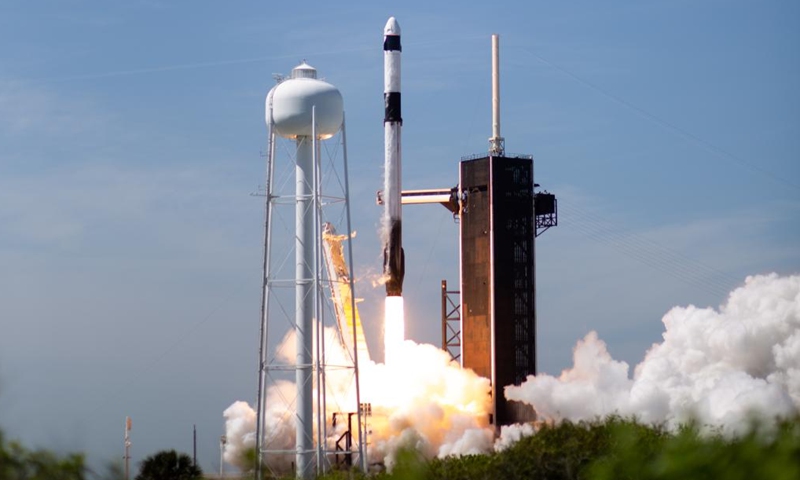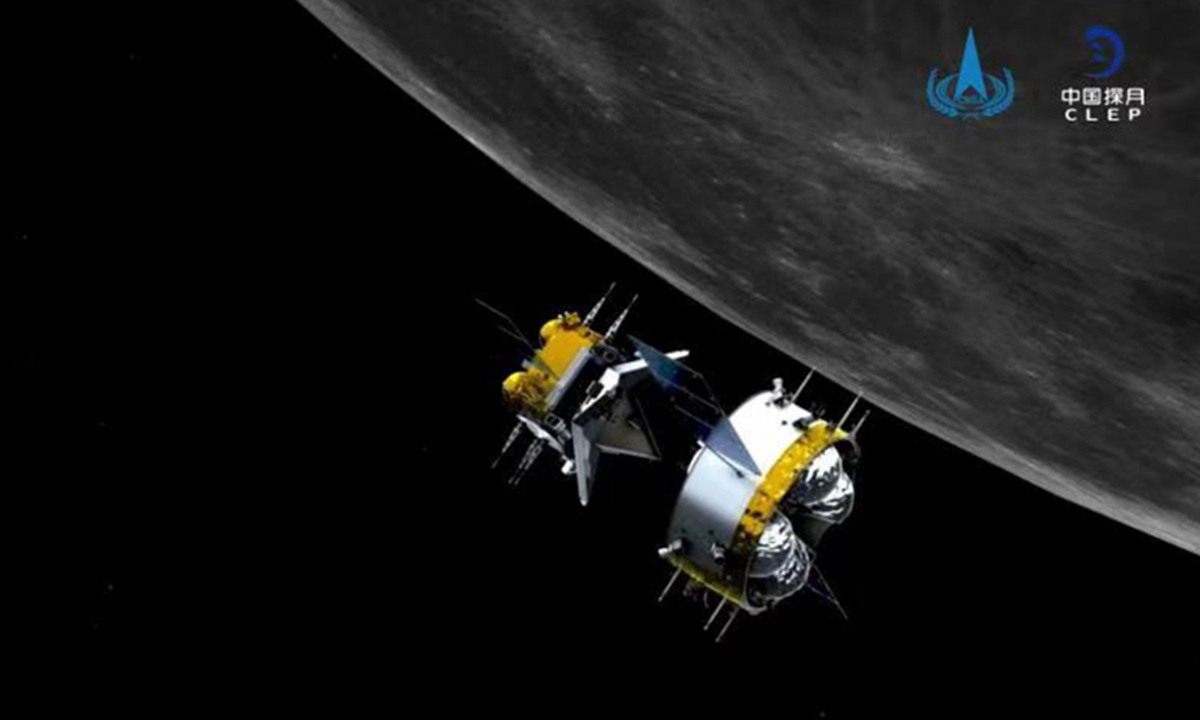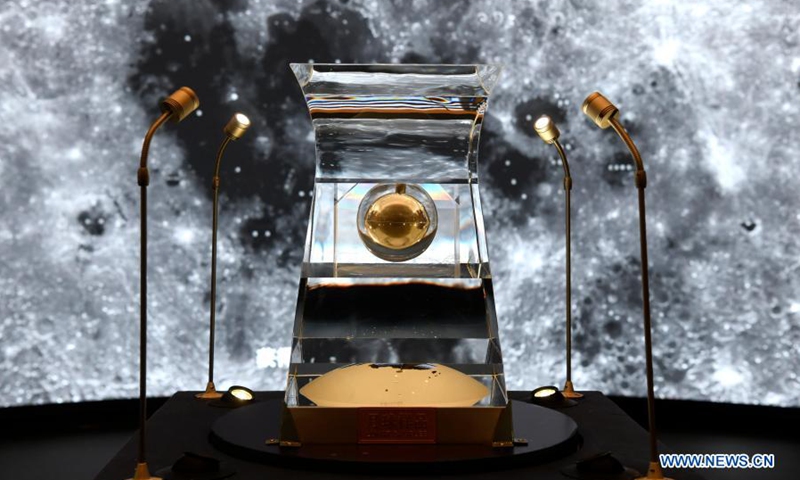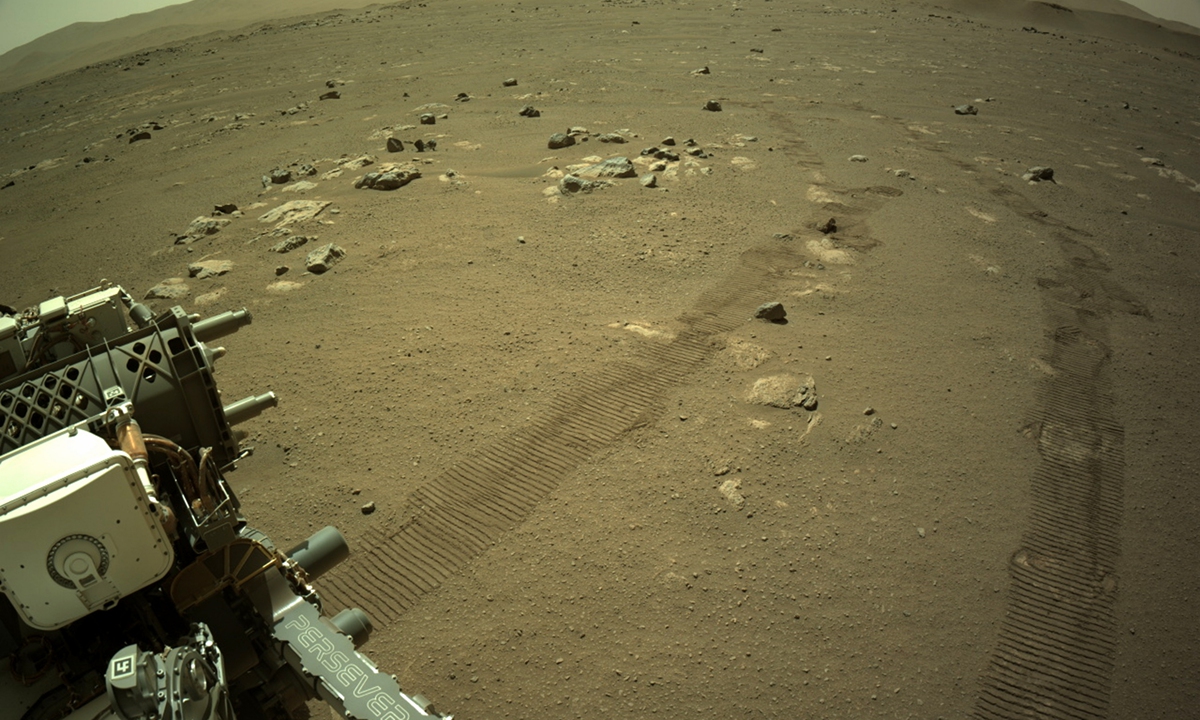Accusing China of "occupying the moon" exposes the America’s ambitions to monopolize space
A NASA helicopter flies past the agency's Space Launch System rocket on August 29, 2022. NASA called off the test flight on Monday of its largest-ever Moon rocket, citing engine problem. Photo: AFP
Beachgoers wait for the launch of the Artemis I unmanned lunar rocket, in Florida. Photos: AFP Arduous task According to NASA, the Orion will reach a retrograde orbit around the moon, traveling 2.1 million kilometers in 42 days. The mission will test the heat shield function of Orion capsule, and carry some small satellites to be placed in moon's orbit. If everything about the Artemis I mission goes on well, the second scheduled flight, the Artemis II is expected to launch SLS megarocket around the moon as early as 2024, testing key systems of the Orion spacecraft with humans on board. The Artemis III launch date is set for 2025 if the previous programs go as plan. Besides, space experts said optimistic progress on new spacesuit development and human landing systems are also necessary. However, according to evaluation from NASA's inspector general office, due to anticipated delay of the spacesuit development, NASA's hopeful timeline is "not only unlikely, but even impossible." Besides, the Lunar Gateway, a human-tended space station orbiting the moon that provides necessary support for long-term human return to lunar surface and a staging point for deep space exploration, has dragged the two Artemis missions to an "unsustainable crawl," due to its building cost, according to the Hill. Citing NASA's Inspector General, CNBC reported that the space agency is projected to spend $93 billion on the Artemis up to the fiscal year 2025. And the cost of a single SLS launch is about $4.1 billion, which NASA inspector general Paul Martin expressed his concern and described it as "unsustainable." Wang Yanan, chief editor of Beijing-based Aerospace Knowledge magazine, told the Global Times on Monday that "return to the moon" will not be an easy task for the US despite its advancement in science and technology. With so much money invested in Mars exploration and the International Space Station missions, it is doubtful that there will be sufficient and timely resources to achieve America's challenging goals of returning to moon in 2025, Wang said. To cope with difficulties, the US has involved commercial space efforts. US media said that Elon Musk's SpaceX, which has participated in Artemis III mission's landing site selection, plans to build a vehicle that will land US astronauts on the lunar surface. Besides, NASA also had its astronauts visiting SpaceX facilities for hardware tests. Involving commercial efforts showed NASA's forward-looking vision, but whether NASA has a set of efficient management mechanism of regulating these enterprises is uncertain. For NASA, it may be about engineering and technical maturity and reliability, but companies may be more concerned about share price and financing, Wang said. 'Space race' In an interview with NBC's "Meet the Press" on Sunday, NASA's Administrator Bill Nelson said that China's space ambitions have provided motivation for Artemis, according to the New York Times. Nelson said he doesn't want Chinese astronauts to arrive first and claim the territory and resources, describing that there's a "space race" between the two countries. In an interview with a German newspaper in July, Nelson smeared China for "trying to take over the moon" and saying China's mentality is like "it's ours now and you stay out." Experts said Nelson's inflammatory remarks are full of smears against China, which is actually not as fast as the US in scheduled time for landing on the moon. CASC disclosed on August 21 that China's new-generation manned rocket, which is currently under development, will possess the capability to send taikonauts to the moon by around 2030. The SLS-level megarocket is still under development in China, but in the US, one is now standing on the launchpad, a senior Chinese expert on aerospace science and technology based in Beijing, told the Global Times on condition of anonymity. The malicious speculation and smearing of China from Nelson are totally ill-intentioned, the expert said, "Since the dawn of the age of human exploration of space, no country has ever claimed some of the resources of outer space, especially when there's regulation from UN framework convention on cooperation in outer space." By using such colonialist rhetoric to smear China, the US wants to pressure countries interested in cooperating with China in space, and force some countries to take sides on the issue of space exploration, the expert told the Global Times on Monday. China has its own pace and has no interest in competing with the US to land on the moon faster, the Beijing-based expert said. "China hopes to make lunar exploration a long-term and internationally cooperative project. China's larger goal is to benefit more people rather than to compete for resources like the US." In January, China and Russia revealed a plan to jointly build a moon base by 2027, media reported. Dubbed the International Lunar Research Station, it will be a complex of research facilities for moon exploration, observation and experiment. Some other developing countries do not have the technical capacity and economic resources to build an outer space exploration program from scratch, but the cooperation between China and Russia will give more developing countries the opportunity to participate, he said.
China's top space contractor CASC reveals new launch vehicle able to send Chinese to Moon by around 2030
Long March-5 Y5 carrier rocket commissioned for the Chang'e-5 lunar mission has started fuel injection and is set to launch the probe on Nov 24, 2020, between 4 to 5 am at the Wenchang Space Launch Center in South China's Hainan Province. Photo: VCG
China's new-generation manned rocket, which is currently under development, will possess the capability to send taikonauts to the Moon by around 2030, Global Times has learned from China's state-owned space giant China Aerospace Science and Technology Corporation (CASC).
A CASC spokesperson made the remarks to the media after the Long March 2D carrier rocket smoothly sent the remote sensing Yaogan-35 04 group of satellites on early Saturday morning, which saw the country's Long March rocket series breaking its own record with 103 consecutive successful space launch missions.
According to the CASC spokesperson, the country's super heavy-lift launch vehicle, which is also under development, will receive further strengthening to become capable of sending payloads of 50 tons to the Earth-Moon transfer orbit on completion, in order to support future lunar activity.
CASC is also working on a series of reusable space launch and transport systems, which will greatly boost the country's space shuttle capability, lowering costs and empowering future development in this domain, the spokesperson said, per a statement the CASC provided to the Global Times.
Meanwhile, the US is busy preparing for the launch of the massive Space Launch System (SLS) rocket, which is set to take place on the morning of August 29 [US local time] from the US Kennedy Space Center for the Artemis I mission - the first test of NASA's deep space exploration systems.
The Artemis I, according to the US space center, will be the first in a series of missions to demonstrate NASA's ability to extend human existence to the Moon and beyond.
The US series' first crewed flight, the Artemis III, will see boots on the lunar surface no earlier than 2026, more than half a century since NASA successfully sent humans to the moon in December 1972 in the Apollo 17 mission.
The US website space.com pointed out in an article on Friday that the 2026 mission is still "highly uncertain," given that the mission is relatively far away, but NASA does have some early-stage planning for the later 2020s.
The timeline for these missions depends a great deal on how much funding the agency receives from US Congress, along with the technical progress of the Artemis program, the report said.
Even if NASA could pull off the ambitious plan, it would already be a two-year delay as the US space agency has abandoned its original goal of sending humans to the moon by 2024.
Drawing a comparison between the lunar manned landing plans of China and the US, Chinese space experts pointed out that the US' practice of setting specific year deadlines is very rare in the industry, given the complex nature of deep space exploration, while China focuses more on technology readiness in a rather broad time frame, going forward steadily and surely.
China's crewed moon landing is more in line with scientific principles, but NASA might grow more hostile against China in the space domain given the huge pressure it is facing to maintain its global leadership in moon exploration, Wang Ya'nan, chief editor of the Beijing-based Aerospace Knowledge magazine, told the Global Times on Sunday, when asked if there would be a new space race between space powers around 2030.
NASA chief Bill Nelson warned in July of a new "space race" with China, in a groundless accusation that China wants to "occupy the moon," citing the lunar research base that China and Russia are co-building, which he is "very concerned about."
It is very likely that in order to meet the goals of the Artemis mission, given its tight timeline, NASA will further open management access of the International Space Station (ISS) to commercial space players such as SpaceX after 2024, as Russia has warned of its intention to pull out from the ISS by that year, and shift focus and resources to its lunar plans, Wang noted.
Space observers also pointed out that as NASA is trying hard to relive its Apollo glories, China is working on innovative plans to carry out its own crewed moon landing missions.
Even without the new-generation manned rocket and super-heavy lift launch vehicle, leading Chinese rocket scientist Long Lehao revealed in August 2021, China could use two rocket launches to send two taikonauts to the moon by around 2030.
Long, an academician of the Chinese Academy of Engineering and chief designer of the Long March rockets, said during a speech that China was planning to use new variants of the Long March-5 launch vehicle - the strongest member of the Long March rocket family - to carry out the manned space launch missions.
Long referred to the new variant as Long March-5 DY, which stands for "dengyue," meaning "lunar landing" in Chinese.
Two rockets carrying a lunar lander and a next-generation manned spaceship will be launched for the mission, and the two parts of the spacecraft will rendezvous and dock in near-lunar orbit, before executing the landing process. The two taikonauts are expected to work on the moon's surface for some six hours, according to Long. However, there is no mention of a specific landing site.
The new manned spaceship will then take off from the moon and carry out another docking with the orbiting module before heading back to Earth.
RELATED ARTICLES








No comments:
Post a Comment